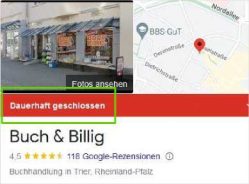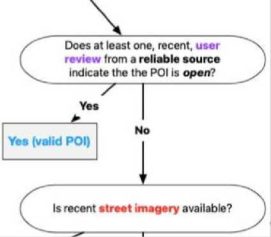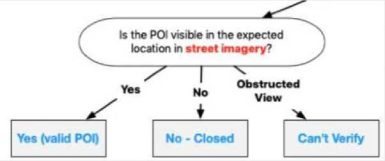Most Common Mistakes in POI Validity
POIs that have relocated
 Important Note: Per section 3.2.4 Search Engine Result Pages (SERPs), don’t rely on automated “closure” indicators like the example below:
Important Note: Per section 3.2.4 Search Engine Result Pages (SERPs), don’t rely on automated “closure” indicators like the example below:
The listing on the left shows an
automated search engine result
indicating the POI is permanently closed.
This is a clue, but additional research is
always required!
Verify validity using OFFICIAL SOURCES.
“Official sources” are official websites or official social media sites maintained by the POI. If there are no official sources proceed to STEP 2 “Reliable Source”.
For POIs with an official website/social media site rate NO-CLOSED if:
For POI’s with poorly maintained official sites/social media sites:
Note: Poorly maintained sites may indicate a need for “reliable resource” evidence (see below).
Verify validity using RELIABLE SOURCES & USER REVIEWS (as needed).
“Reliable sources” are news articles from primary publications that do their own reporting, crowdsourced user review sites (Trip Advisor, Yelp, etc.), government business registries or unofficial social media.


Provide additional support using RECENT STREET VIEWS (as needed)
“Recent street views” are images dated less than one year old.
empty, for sale or the POI has been replaced); then rate “NO-CLOSED.”

Leave comments related to validity issues.
Comments should include the verification process steps followed and any reasons you could not verify a POI’s validity along with links to sources used.
In addition, comments are required anytime research findings contradict the POI listing. Comments should include:
‘• if applicable, reasons you could not verify the POI
Regular stores versus back offices
Especially for chain businesses (butin all other such cases as well), it is important to distinguish between regular branch locations open for the public and non-public offices or facilities, like e.g. administration or operations offices. Company headquarters of store chain businesses are also falling in this category. These locations are not expected to be accessed by the public and do not have open hours. According to section 3.1 they are not valid POI’s.
Most Common Mistakes in Address Accuracy
Street name and postal codes are two areas in which a second look for possible differences between the address components in the task and in official sources might be beneficial as it is apparent in the following case:
The address displayed in the task is “Hauptkanal Rechts 96, 26871 Papenburg”. On the official website of the POI the street name is written as “Hauptkanal rechts”. Other official sources for verifying an address, like governmental and postal address services, also return this writing of the street name. This address component is obviously mistyped and should be rated as Incorrect – Street name.
Another area of potential mistakes are postal codes. Incorrect numbers can easily be overlooked. Always consider to take regular breaks after some time while rating.
According to GL section 7.1 in cases of branches of chain businesses the main page of the official website is Partially Correct, if a location-specific page for the POI exists on the official website. If the URL is the main page of the official website, it is always indicated to look for a location-specific page for the POI on this website. If this is the case, then this page is the correct URL for this POI.
In cases of POI’s with alternative names the official website of the same POI is the correct URL even if the website lists a different name than the POI name in the task, as long as it is the same POI.
Most Common Mistakes in Category Accuracy
In category ratings we have seen ratings resulting from inaccurate assessments of the main purpose of businesses. It is always indicated to research the main or dominant area of a business for a decision of the correct and best fitting category for a POI. According to section 8.2, the listed category should provide the “best fit” for the POI from all possible categories. Fit is determined in terms of accuracy and scope. In other words, the best fit category must correctly describe the POI, as well as represent the dominant identity of the POI.
A category is Incorrect if it is not a correct representation of a business. This is e.g. the case, when a business delivery service is categorized as a store. A store is a location with access for customers and regular open hours. A business delivery service works with orders from businesses, usually has no publicly accessible store and delivers the ordered goods to other businesses. The category trees are very different as can be seen in this example of a beverage supplier, which delivers to gastronomy businesses and event service companies, compared with a beverage store:
commercial sector ➞ wholesaler ➞ commodities supplier ➞ food supply and distribution ➞ beverage supplier
shopping ➞ food mart ➞ beverage store
The category beverage store for a business delivery service would be Incorrect.
A further topic are situations, in which a dominant category is not recognizable for a POI. This might be the case if a restaurant offers a mix of different dishes with no dominant kind of dish. In such situations, the POI name can be taken into account for a decision. According to section 8.2 of the GL, the first category keyword that appear in the business name should then be selected as the best fit category. If the category listed in the task is also represented by the POI, but not mentioned as the first keyword in the name, this category would be Approximate – too specific.
It is always important to look if a more specific category exists for a POI that describes it better and more precise. In such cases, the category rating should be Approximate – too general and the better fitting category can be selected in the task interface.
There are also situations with a specific category in the task, which represents only a part of the POI. In these cases, a broader category with an overall better fit should be selected and the correct rating is Approximate – too specific.
An example would be the case, when a regular supermarket is categorized in the task as a fruit store. Although fruits are also offered in a supermarket, such stores contain all kind of food products and small household goods as well. Fruit stores are specialized in selling fruits only. When looking at the category trees we can see that both categories are sub-categories of the broad category food mart:
shopping ➞ food mart ➞ produce store ➞ fruit store
shopping ➞ food mart ➞ grocery store ➞ supermarket
In such cases, the correct rating would be Approximate – too specific, because fruits are only one product section in supermarkets among many others.
Regarding the open hours of schools in section 10.6.2.2 of the GL it is explained, that these POI’s are not expected to have published open hours. In cases, where no open hours are available on official sources and the task does not list open hours, the ratting should be OK Without. However, if there are hours for facilities of the school, like administrative offices or academic departments on the official website, these may be rated as open hours for the POI. A special case are regular class schedules, which are valid for the whole school, like e.g. the weekly training plan for a sports school. These can also be considered as open hours, if there are no general open hours of the school listed on the official website.
GL 10. Hours states that only official sources are allowed for hour ratings; however, we have seen ratings based on crowdsourcing review sites, competitor SERPs and third-party aggregators, including, but not limited to, Google map links, social media sites not claimed by the POI, etc. Please be sure to only use official sources when rating POI hours.
Analysts outside of the locale were sometimes unable to access the official sources due to international access restrictions, so they used unofficial sources instead. As a reminder, the GL (Appendix: Releasing a Survey) state that POIs with international access restrictions on official websites should be released under the “Other” option.
Most Common Mistakes in Pin Accuracy
Pin ratings should always reflect the correct location of a POI. If address components of a POI are incorrect, then the Pin should be on the correct address of the POI. In such cases it is possible, that the Pin is placed on the incorrect address. The rating should then be according to section 9 of the GL, which might be Next Door or Wrong, and the correct location of the Pin on the intended property should be determined with the Pin tool in the map in Tryrating.